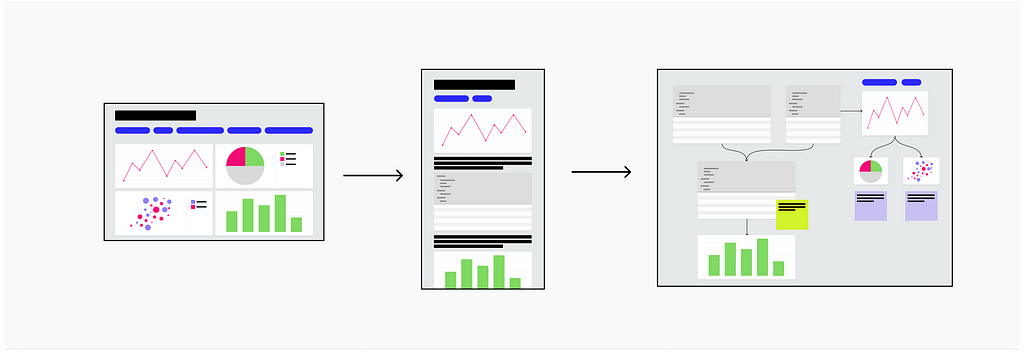https://ift.tt/gSBoHY6 On April 9, 2020, I published an essay called “ Dashboards are Dead ”. I wrote it mainly to vent my pent-up frustrat...
On April 9, 2020, I published an essay called “Dashboards are Dead”. I wrote it mainly to vent my pent-up frustrations as a data analyst, and yes, also to take on the most popular data tool at the time: the dashboard.
To my surprise, a lot of people read it. Over 60,000 people in the first weekend alone, and over 250,000 as of writing this. Something in the now-infamous article clearly resonated with others (or just really pissed them off). Over the last three years, I’ve attempted to write various follow-up articles but have shied away at the last moment, not sure exactly what I wanted to say.
This weekend marks three years since that article, and by now I might have just enough distance to see things clearly — both where the industry was then, and how far we’ve come.

Dashboards aren’t dead
Don’t worry, I see the elephant in the corner.
Of course, dashboards aren’t actually dead. For the record, that wasn’t what I was suggesting.
The point I was trying to make is that dashboards have always been good for one thing: quickly displaying numbers. But we’ve been misusing them by expecting them to do everything for us. We’ve asked them to tell stories, be visually appealing, convey information quickly, act as a data portal, and do anything else we could think of. Of course, they couldn’t do all of that.
I do believe that sometimes dashboards are the best option. But I also strongly believe we deserve better.
They are dying though
To say some people had strong reactions to the article might be an understatement (just go look at the comments). Even people who agreed with the fundamental failings of dashboards had a hard time imagining their demise.
But today, things are decidedly different. Dashboards are no longer the darlings of the data community. Tableau has seemingly fallen from grace, and semantic layers promise to fundamentally shake up this space.
Furthermore, we’ve never had so many alternatives to sharing a dashboard. A data team can now choose between reverse ETL, BI notebooks, data canvases, self-service solutions, and embedded analytics. It has been exciting to see these new options appear, as each one slightly changes how we approach the problem at hand — which is exactly the point…
This was never just about dashboards
What I’ve come to see more clearly in the last few years is that “Dashboards are Dead” has a lot less to do with dashboards than, well, everything around them. In the end, the root of my discontent was the relationships, communication, processes, and people. But it’s much simpler to blame the tool that was jammed in to solve all of those problems at once.
This complicates the problem substantially. Changing how we work is much more difficult than adopting new tools. It requires us to fundamentally think differently about the problem, our roles, and our relationships.
And here, we’ve made some exciting progress in the last 3 years:
Analysts aren’t just chart builders
When DaD was published many people asked the question ‘If analysts aren’t building dashboards, what will they do?’
It’s crazy to think that we once believed analysts to be inextricably linked to dashboards, given how much more they are associated with today. Analysts are now explorers, data translators, and trusted advisors to the business. They are finally getting their mojo back.
This shift in perception of the analyst is particularly timely, given the undeniable role AI will play in building our charts soon enough.
More than a defensive maneuver, though, this shift is required for our own well-being. I’ve met too many data analysts over the last 5 years that were so cynical, and so let down by their time as an analyst that they were giving up their data careers entirely. Here, at least is one people problem that is getting much-needed attention. If I’m being really optimistic (which I am known for), then I think we might see an analyst renaissance coming soon.
We’re asking bigger questions
As an analyst, when no one was looking at one of our dashboards, our managers put it on us. “Don’t you know the design principles? Are you using the right colors? Putting information in the right order?”
It’s easy to look back now and realize that no amount of design expertise was going to get some of those dashboards to be looked at more than once. They were fundamentally the wrong solution, not the wrong design.
As an industry, we seem to have come to the same conclusion, moving away from ‘how to make this dashboard great’ towards ‘what’s the best way to deliver this information?’
The difference is subtle, but the latter offers so many more possible solutions. And we’re finally ready to throw some ideas around.
Is data a product? What are the pros/cons of implementing the data mesh? How far down the self-service spectrum should we go?
I love these questions. They so effectively ask us to examine who we are and who we are not. These discussions and experiments are necessary, and indeed, indispensable if we are really to make a leap forward.
We’ve got further to go
Despite these initial promising signs of change, the fact remains that most of the issues that drove me to write DaD are still rampant. As I see it, to tackle them, we have three key problems to solve:
1 — Balancing the stack
So far I have not even brought up what’s changed the most in the last 3 years: the back of the stack. What was before a few scheduled views in our database is now a complex ecosystem of interconnected pipelines, orchestration schedules, and intricate database environments. We’ve come so far here, it’s really quite astounding if you take a step back.
What we haven’t yet done, though, is turned those back-of-stack innovations into front-of-stack value. We are still figuring out what we can do with it all.
To do this, we need to get out of our bubble and balance our energy across the stack.
2 — Trust is about more than being right
Perhaps as a result of so much focus on our pipelines, data teams today are culturally different than 3 years ago. Today the main objective seems to be building trust through reliability and accuracy.
As a result, many teams are far more locked-down and process-driven than they used to be. These gates help optimize for accuracy and reliability by reducing the chance of someone deploying a bad bit of code and ruining everyone’s reports the next day.
A culture built on establishing trust is a great goal. But being accurate is not the only way we establish trust.
Trust is also about relationships, communication, and even feeling free to make mistakes.
A culture that curates those values and reliability has the potential to dramatically improve life for both data teams and the stakeholders we support.
3 — We still need the right tools
Great software brings out the best in us. To make the kind of changes we are talking about here, we are going to need a little support from good software. In particular, ones that:
- Prioritize collaboration: If we are to improve relationships between data and business teams, we need our tools to actively create a space for how that will work
- Reinforce trust through transparency: No more ‘hidden queries’. If we care about trust, then what better way than to be transparent about exactly where a number came from?
- Are flexible enough to let us experiment: I do not believe there will be one tool to replace dashboards entirely. We will need different solutions for different things, things we cannot even yet anticipate.

Aside: I know everyone really loved this part of DaD when I talked about how great count.co was for this kind of thing, but I will refrain this time and just say this: Yes, count.co is hoping to help here. We left the BI notebook game behind in favor of a more collaborative and flexible canvas. And yeah, I’m bullish on it, but that’s why I work there 😀.
What now?
Three years ago, a lot of us agreed on how dashboards were failing us. It’s only now, three years later, that we are beginning to turn that nascent frustration into tangible and robust changes.
So really what I’m saying is, we’re finally getting to the good part. Buckle up.
Dashboards are dead: 3 years later was originally published in Towards Data Science on Medium, where people are continuing the conversation by highlighting and responding to this story.
from Towards Data Science - Medium
https://towardsdatascience.com/dashboards-are-dead-3-years-later-72347757bfa6?source=rss----7f60cf5620c9---4
via RiYo Analytics

No comments